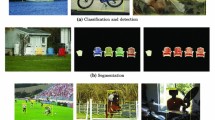Abstract
This paper is concerned with the general topic of recognizing the plan of a user, to include a representation of the user's plans as part of a user model. We focus on extending the coverage of plan recognition, by allowing for additional detail in the user's plan beyond fixed specifications of possible plans in a system's library. We provide procedures for handling two distinct extensions: recognizing temporal constraints from the user and admitting novel information. We conclude by commenting on the importance of these extensions when including plans in a user model in order to enhance communication between the system and the user.
Similar content being viewed by others
References
Allen, J. F.: 1983, Maintaining Knowledge about Temporal Intervals.Communications of the ACM 26, 832–843.
Appelt, D. E. and Pollack, M. E.: 1991, Weighted Abduction for Plan Ascription.UMUAI, forthcoming.
Bratman, M., Israel, D., and Pollack, M.: 1988, Plans and Resource-Bounded Practical Reasoning.Computational Intelligence 4, 349–355.
Calistri-Yeh, R. J.: 1991, Utilizing User Models to Handle Ambiguity and Misconceptions in Robust Plan RecognitionUMUAI, forthcoming.
Carberry, S.: 1985, Pragmatic Modeling in Information System Interfaces. Ph.D. thesis available as University of Delaware Technical Report 86-07, Newark, Del.
Carberry, S.: 1988, Modeling the User's Plans and Goals.Computational Linguistics 14, 23–27.
Carberry, S.: 1989, A Pragmatics-Based Approach to Ellipsis Resolution.Computational Linguistics 15, 75–96.
Charniak, E. and McDermott, D.: 1985,Introduction to Artificial Intelligence, Addison Wesley.
Cohen, R.: 1987, Analyzing the Structure of Argumentative Discourse.Computational Linguistics 13, 11–24.
Cohen, R., Jones, M., Sanumgasunderam, A., Spencer, B., and Dent, L.: 1989, Providing Responses Specific to a User's Goals and Background.International Journal of Expert Systems 2, 135–162.
de Kleer, J.: 1986a, An assumption-based Truth Maintenance System.Artificial Intelligence 28, 127–162.
de Kleer, J.: 1986b, Extending the ATMS.Artificial Intelligence 28, 163–196.
de Kleer, J.: 1988, A General Labelling Algorithm for Assumption based Truth Maintenance.Proceedings of the Seventh National Conference on Artificial Intelligence, St. Paul, Minn., pp. 188–192.
Eller, R. and Carberry, S.: 1991, A Meta-Rule Approach to Flexible Plan Recognition in Dialogue.UMUAI, forthcoming.
Goodman, B. A. and Litman, D. J.: 1991, On the Interaction between Plan Recognition and Intelligent Interfaces.UMUAI, forthcoming.
Joshi, A., Webber, B., and Weischedel, R.: 1984, Living up to Expectations: Computing Expert Responses.Proceedings of the Third National Conference on Artificial Intelligence, Austin, Tex., pp. 169–175.
Kautz, H.: 1987, A Formal Theory of Plan Recognition. Ph.D. thesis available as University of Rochester Technical Report 215, Rochester, N.Y.
Kautz, H. and Allen, J.: 1986, Generalized Plan Recognition.Proceedings of the Fifth National Conference on Artificial Intelligence, Philadelphia, Penn., 32–37.
Katz, M., Chakeres, M., and Bromberg, M.: 1975,Real Stories. Book One, 2nd edition, Globe Book Company, New York.
Konolige, K. and Pollack, M.: 1989, Ascribing Plans to Agents.Proceedings of the Eleventh International Joint Conference on Artificial Intelligence, Detroit, Mich.
McKeown, K. R., Wish, M., and Matthews, K.: 1985, Tailoring Explanations for the User.Proceedings of the Ninth International Joint Conference on Artificial Intelligence, Los Angeles, Calif., pp. 794–798.
Perrault, C.R., Allen, J., and Cohen, P. R.: 1978, Speech Acts as a Basis for Understanding Dialogue Coherence.Proceedings of the Second Conference on Theoretical Issues in Natural Language Processing (TINLAP), Urbana-Champaign, Ill., pp. 125–132.
Pollack, M.: 1986a, A Model of Plan Inference that Distinguishes Between the Beliefs of Actors and Observers.Proceedings of the 24th Conference of the Association for Computational Linguistics, New York, N.Y., pp. 207–214.
Pollack, M.: 1986b, Inferring Domain Plans in Question-Answering. Ph.D. thesis (Univ. of Penn.) available as Technical Note 403, SRI International.
Pollack, M.: 1989, Plan Recognition Beyond STRIPS.Proceedings of IJCAI89 Workshop on Plan Recognition.
Poole, D., Goebel, R., and Aleliunas, R.: 1987, Theorist: a logical reasoning system for defaults and diagnosis. InThe Knowledge Frontier: Essays in the Representation of Knowledge, N. Cereone and G. McCalla (eds.), Springer Verlag, New York, pp. 331–352.
Proceedings of the 2nd AAAI Workshop on Plan Recognition: 1989, IJCAI-89, Detroit, Mich.
Raskutti, B. and Zukerman, I.: 1991, Generation and selection of Likely Interpretations during Plan Recognition in Task-Oriented Consultation SystemsUMUAI, forthcoming.
Reichenbach, H.: 1947,Elements of Symbolic Logic, New York, pp. 287–299.
Sider, J. S. and Burger, J. D.: 1991, Intention Structure and Extended Responses in a Portable Natural Language Interface.UMUAI, forthcoming.
Song, R: 1991, A Processing Model for Temporal Analysis and its Application to Plan Recognition. Ph.D. thesis, University of Waterloo.
Song, R and Cohen, R.: 1988, The Interpretation of Temporal Relations in Narrative.Proceedings of the Seventh National Conference on Artificial Intelligence, pp. 745–750.
Song, R and Cohen, R.: 1991, English Tense Structures and Their Processing in the Context of Narrative. In preparation.
Spencer, B.: 1990, Avoiding Duplicate Proofs. InProceedings of the North American Conference on Logic Programming, S. K. Debray and M. Hermenegildo (eds.), MIT Press.
Spencer, B.: 1991, Assimilation in Plan Recognition via Truth Maintenance with Reduced Redundancy. Ph.D. thesis, University of Waterloo. In preparation.
Spencer, B. and van Beek, P.: 1989, Applying Truth Maintenance to a Network of Constraints.Proceedings of the Workshop on Constraint Processing Algorithms and their Applications, IJCAI, Detroit, Mich.
van Beek, P.: 1987, A Model for Generating Better Explanations.Proceedings of the 25th Conference of the Association for Computational Linguistics, Stanford, Calif., pp. 215–220.
van Beek, P.: 1989, Approximation Algorithms for Temporal Reasoning.Proceedings of the Eleventh International Joint Conference on Artificial Intelligence, Detroit, Mich., pp. 1291–1296.
Webber, B. L.: 1987, The Interpretation of Tense in Discourse.Proceedings of the 25th Conference of the Association for Computational Linguistics, Stanford, Calif., pp. 147–154.
Webber, B. L.: 1988, Tense as Discourse Anaphor.Computational Linguistics 14, 61–73.
Author information
Authors and Affiliations
Rights and permissions
About this article
Cite this article
Cohen, R., Song, F., Spencer, B. et al. Exploiting temporal and novel information from the user in plan recognition. User Model User-Adap Inter 1, 125–148 (1991). https://doi.org/10.1007/BF00154475
Received:
Revised:
Issue Date:
DOI: https://doi.org/10.1007/BF00154475




